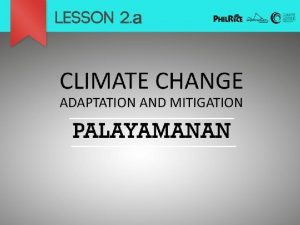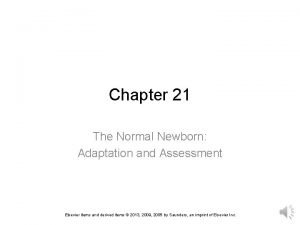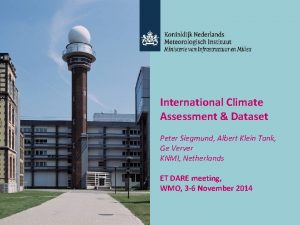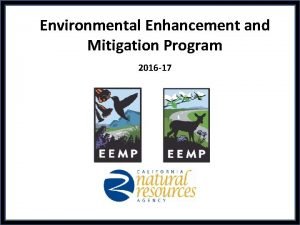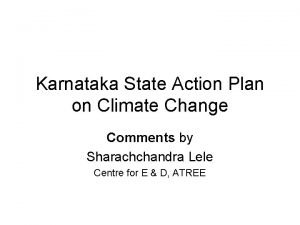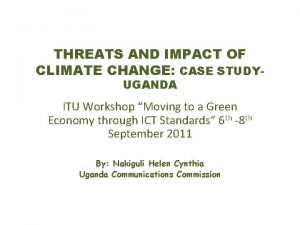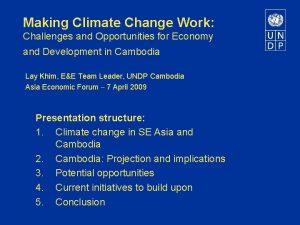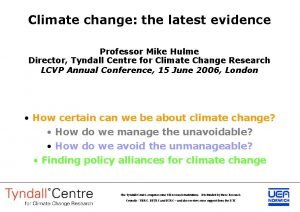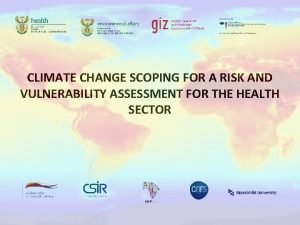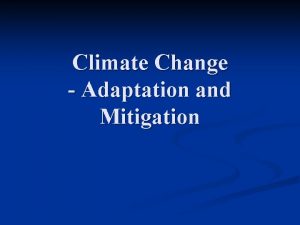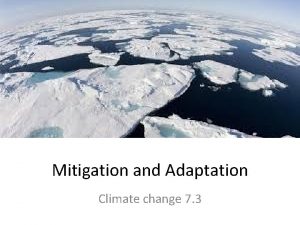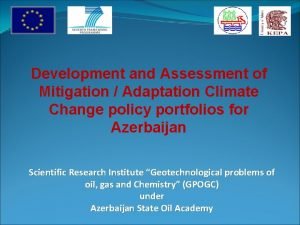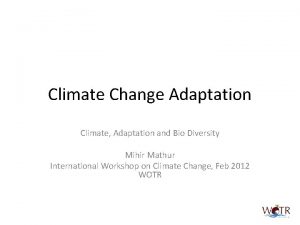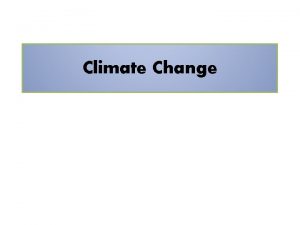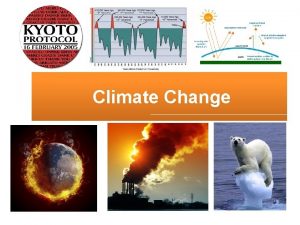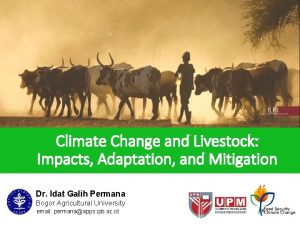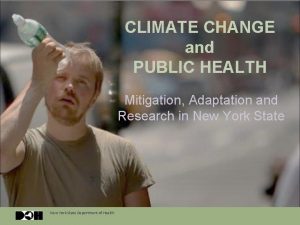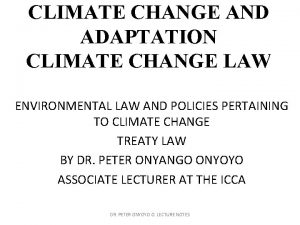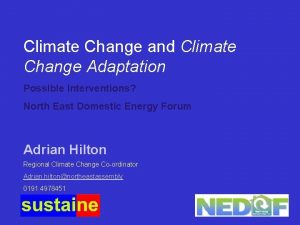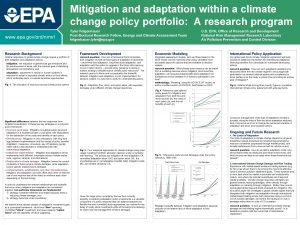Development and Assessment of Mitigation Adaptation Climate Change































- Slides: 31

Development and Assessment of Mitigation / Adaptation Climate Change Policy Portfolios for Turkey Nuray AKALIN TUBİTAK-Marmara Research Center 9 October 2013 Athens PROMITHEAS -4 “Knowledge transfer and research needs for preparing mitigation/adaptation policy portfolios” 1

Objectives of the Turkish CC Policy • Turkey became a party to UNFCCC on 24 May 2004. • Decision (26/CP. 7) of Conference of the Parties-7 (COP 7) that was held in Marrakech in 2001 deleted Turkey from Annex II - but the country remained as an Annex-I Party of the UNFCCC - and recognized the special circumstances of the country as being different from that of the other Annex I countries of the Convention. • Turkey ratified Kyoto Protocol on August 26 th, 2009. • Turkey does not have a quantified emission limits or reduction commitments for the first commitment period (2008 -2012) under the Protocol. PROMITHEAS -4 “Knowledge transfer and research needs for preparing mitigation/adaptation policy portfolios” 2

Objectives of the Turkish CC Policy • Turkey is an observer to the Energy Community. Countries with full membership will apply European Union (EU) directives related to the use of Renewable energy sources (RES) and the promotion of energy efficiency. • Turkey is a candidate country for EU membership. PROMITHEAS -4 “Knowledge transfer and research needs for preparing mitigation/adaptation policy portfolios” 3

Objectives of the Turkish CC Policy • Main plans/strategies related with climate change in Turkey, – National Climate Change Strategy, 2010 -2020 – National Climate Change Action Plan, 20112023 – Strategic Plan of the Ministry of Energy and Natural Resources, 2010 -2014 – Electricity Energy Market and Supply Security Strategy – Energy Efficiency Strategy, 2012 -2023 PROMITHEAS -4 “Knowledge transfer and research needs for preparing mitigation/adaptation policy portfolios” 4

CC Mitigation Options for Turkey • Explotation of RES – – – Hydropower: 36. 000 MW Wind: 20. 000 MW Solar: 3. 000 MW Geothermal: 600 MW Biomass: 2. 000 MW – İncentives • Energy Efficiency – Energy-saving potential of • 30% in the building sector • 20% in the industry sector • 15% in the transport sector – Increase capacity and efficiency of existing thermal plants by rehabilitation activities – Reduce nationwide electricity distribution losses – Incentives and awareness-raising campaigns PROMITHEAS -4 “Knowledge transfer and research needs for preparing mitigation/adaptation policy portfolios” 5

CC Mitigation Options for Turkey • Fuel switch – 5% biofuel can be added to other types of fuel in the country. – Increase use of RES for electricity production, – Start use of nuclear energy for electricity production. • Mitigation through emission trading – Estimated annual CO 2 reduction by voluntary market projects was 12 million ton by 2012, – Other mechanisms for future. PROMITHEAS -4 “Knowledge transfer and research needs for preparing mitigation/adaptation policy portfolios” 6

Adaptation Needs in Turkey The following sectors will effected from the changes in temperature and precipitation caused by climate change: • Energy sector – Temperature rise – Fluctuations in water resources – Hydropower is directly related with amount of water resources • Water resouces • Agriculture • Forestry PROMITHEAS -4 “Knowledge transfer and research needs for preparing mitigation/adaptation policy portfolios” 7

Business As Usual (BAU) Scenario • The policy portfolio of BAU includes the implemented policy instruments related with climate change issues before 31 December 2010, • RES applications, notably hydro and wind, increased considerably after old RES Law entered into force in 2005, • Turkey does not have an organized commercial and domestic photovoltaic program, • Also, tariffs were low compared to other EU countries, although multiple tariffs were envisaged by the amended RES Law. But, the Law entered into force after 31 December 2010, so, it is not considered in BAU. PROMITHEAS -4 “Knowledge transfer and research needs for preparing mitigation/adaptation policy portfolios” 8

Business As Usual (BAU) Scenario • In the framework of The Energy Efficiency Law, rehabilitation of thermal power plants, decrease of losses, incentives and awareness raising are considered in BAU, • No CDM projects are completed, because Turkey cannot participate in the flexible mechanisms of the Kyoto Protocol, • In BAU, only projects in the Voluntary Carbon Market are taking into account, • No adaptation measures are implemented. PROMITHEAS -4 “Knowledge transfer and research needs for preparing mitigation/adaptation policy portfolios” 9

Optimistic (OPT) Scenario • The mitigation/adaptation policy instruments that the country has set into force after 1 st January 2011, • Additional policy instruments in line with the EU climate change policy that can be adjusted to the needs and priorities of the examined country, • The maximum exploitation of the potential of the country in energy efficiency and renewable energy sources, • Improvement of network capacity. PROMITHEAS -4 “Knowledge transfer and research needs for preparing mitigation/adaptation policy portfolios” 10

Optimistic (OPT) Scenario • The policy instruments used in OPT: – Amended RES Law: Law on Utilization of Renewable Energy Sources for the Purpose of Generating Electricity (Official Gazette No: 27809, 8 January 2011) – Regulation on increasing efficiency in the use of energy resources and energy (Official Gazette No: 28097, 27 October 2011) • Additional policy instruments in OPT: – RES incentives should be increased to provide usage of max RES potential, – Additional policy instruments should be added so as to reinforce the up to now set of policy instruments for the promotion of EE, – Development of new policies for emission trade. PROMITHEAS -4 “Knowledge transfer and research needs for preparing mitigation/adaptation policy portfolios” 11

Pessimistic (PES) Scenario • The mitigation/adaptation policy instruments that the country has set into force after 1 st January, • No other additional policy instruments apart from those already decided to be implemented and in line with the EU climate change, • The minimum exploitation of the potential of the country in energy efficiency and renewable energy sources by limiting the possible technological options to the sectors. PROMITHEAS -4 “Knowledge transfer and research needs for preparing mitigation/adaptation policy portfolios” 12

Pessimistic (PES) Scenario • It is assumed that hydropower and wind energy will be used at max level and other RES resources will be used 50% untill 2023. • Due to the national targets concerning the reduction of import dependency, the government plans to increase the coal and nuclear based plants. • The policy instruments that form the policy portfolio of the BAU scenario are also included in this scenario, but with the modifications due to the update of RES and Energy Efficiency Laws. PROMITHEAS -4 “Knowledge transfer and research needs for preparing mitigation/adaptation policy portfolios” 13

Main Key Assumptions • Population (BM, 2010): Average annual rate of change (%) Variant Medium 2005 -2010 -2015 -2020 -2025 2030 -2035 2040 -2045 -2050 1. 31 1. 14 0. 95 0. 78 0. 48 0. 21 PROMITHEAS -4 “Knowledge transfer and research needs for preparing mitigation/adaptation policy portfolios” 20502055 -0. 04 14

Main Key Assumptions • GDP (IMF, 2011): Year Annual percent change of GDP (%, constant prices) 2011 8. 503 2012 2. 969 2013 2014 2015 2016 2017 3. 528 4. 002 4. 259 4. 414 PROMITHEAS -4 “Knowledge transfer and research needs for preparing mitigation/adaptation policy portfolios” 4. 447 15

Main Key Assumptions • Sectoral GPD distribution: PROMITHEAS -4 “Knowledge transfer and research needs for preparing mitigation/adaptation policy portfolios” 16

LEAP Results PROMITHEAS -4 “Knowledge transfer and research needs for preparing mitigation/adaptation policy portfolios” 17

Energy Demand PROMITHEAS -4 “Knowledge transfer and research needs for preparing mitigation/adaptation policy portfolios” 18

Electrcity Generation PROMITHEAS -4 “Knowledge transfer and research needs for preparing mitigation/adaptation policy portfolios” 19

GHG Emissions PROMITHEAS -4 “Knowledge transfer and research needs for preparing mitigation/adaptation policy portfolios” 20

LEAP Results for BAU • Energy demand as well as GHG emissions overdoubled within the 20 -year period 19902010. • For the BAU scenario, GHG emissions in Turkey will increase by 269% in 2020 and by 1104% in 2050 compared to the year 1990. Compared to the year 2010, the emissions will increase by 70. 13% and by 455% respectively. • The share of RES in electricity generation in 2023 will be 26. 5%. PROMITHEAS -4 “Knowledge transfer and research needs for preparing mitigation/adaptation policy portfolios” 21

LEAP Results for OPT • For the OPT scenario, GHG emissions in Turkey will increase by 78. 62% in 2020 and by 882. 8% in 2050 compared to the year 1990, while compared to the year 2010, there will be a decrease of 17. 66% and an increase of 353. 05% respectively. • The share of RES in electricity generation in 2023 will be 47. 7%, almost 20% more than BAU because of the introduction of solar and the increased penetration of wind, hydro and geothermal in electricity generation through the reinforced feed-in tariff system and the increased amount of subsidies. PROMITHEAS -4 “Knowledge transfer and research needs for preparing mitigation/adaptation policy portfolios” 22

LEAP Results for PES • According to the outcomes of the LEAP model for the PES scenario, GHG emissions in Turkey will increase by 191. 4% in 2020 and by 1023% in 2050 compared to the year 1990 while compared to the year 2010, they will increase by 34. 35% and by 417. 7% respectively. • The share of RES in electricity generation in 2023 will be 46. 9%. PROMITHEAS -4 “Knowledge transfer and research needs for preparing mitigation/adaptation policy portfolios” 23

AMS Results Scenarios Criteria BAU Opt Pes 0 83. 300 33. 949 Indirect environmental effects (0. 167) Environmental performance (0. 168) - A Cost efficiency (0. 473) Dynamic cost efficiency (0. 183) Competitiveness (0. 085) Equity (0. 175) Flexibility (0. 050) Stringency for non-compliance (0. 034) Political acceptability (0. 738) - B Implementation network capacity (0. 309) Administrative feasibility (0. 581) Financial feasibility (0. 110) 0 0 0 5. 060 3. 539 0 0. 975 1. 133 10. 708 13. 718 19. 367 3. 058 16. 700 100. 00 47. 300 8. 080 3. 539 17. 500 2. 467 1. 133 80. 019 8. 591 19. 367 4. 883 8. 787 42. 736 12. 969 5. 060 1. 422 7. 138 1. 557 1. 133 29. 280 8. 591 19. 367 3. 058 Feasibility of implementation (0. 094) - C 36. 143 32. 841 31. 016 Total (A+B+C) 11. 300 78. 941 31. 704 Direct contribution to GHG emission reductions (0. 833) PROMITHEAS -4 “Knowledge transfer and research needs for preparing mitigation/adaptation policy portfolios” 24

AMS Results • The BAU scenario is characterized by the highest final energy consumption and the worst environmental performance, compared to the other scenarios, which results from the limited number of mitigation and adaptation policy instruments. • PES is characterized by moderate environmental performance. • OPT has the lowest amount of GHG emissions and the lowest energy consumption. PROMITHEAS -4 “Knowledge transfer and research needs for preparing mitigation/adaptation policy portfolios” 25

AMS Results • The policy portfolio of the OPT scenario is overall the most promising scenario – the best performance towards the reduction of GHG emissions, – it ends up as the most cost effective, especially for certain target groups (buildings, industrial sector) – the most fair towards the contribution of the sectors to emission reductions offering more incentives and options (subsidies, feed in tariffs) PROMITHEAS -4 “Knowledge transfer and research needs for preparing mitigation/adaptation policy portfolios” 26

Needs and Gaps • Historical data limitations: – No projections for GDP were in national level. – The historical GDP data was available from 1998. There is a forecast for GDP growth till 2017– the one by IMF. Therefore, a recent GDP growth forecast till 2050 is needed. – Limited data for water use – No data about heat waves and frost days are available. – No historical data about surface, ground and renewable fresh waters are available and overlap separately. PROMITHEAS -4 “Knowledge transfer and research needs for preparing mitigation/adaptation policy portfolios” 27

Needs and Gaps • Information gaps concerning historical data for energy demand: – Although there are many small CHP and bio-fuel production plants, they are not included separately in Energy Balance Tables. – For all transport modes (road, rail, air and maritime), the separate energy use are not available as passenger and freight. There are some emission reduction targets for passenger and freight transports at different transportation modes. It is not possible to figure out the policies & measures in LEAP. – The output fuel data by type in Refining Process is not open due to national interest. PROMITHEAS -4 “Knowledge transfer and research needs for preparing mitigation/adaptation policy portfolios” 28

Needs and Gaps • Turkey has many mitigation and adaptation policies and measures in the Strategy Document and Action Plans which were approved by the Government. • But these measures are expressed as percentage and overlapped measures. • To use these measures in the LEAP, it is needed to convert the percentage data to exact energy use reductions or emission reductions. • The effects of the measures should be monitored systematically. This is very important for modeling the measures in LEAP and justifying in AMS. PROMITHEAS -4 “Knowledge transfer and research needs for preparing mitigation/adaptation policy portfolios” 29

National Workshop National workshop held on 31 May 2013 in Ankara PROMITHEAS -4 “Knowledge transfer and research needs for preparing mitigation/adaptation policy portfolios” 30

Thank you for your attention. . . Nuray AKALIN nuray. guler@tubitak. gov. tr Environmental and Cleaner Production Institute TÜBİTAK MAM www. mam. gov. tr PROMITHEAS -4 “Knowledge transfer and research needs for preparing mitigation/adaptation policy portfolios” 31
 Climate change 2014 mitigation of climate change
Climate change 2014 mitigation of climate change Climate change mitigation
Climate change mitigation Larawan ng pakikibagay
Larawan ng pakikibagay Mitigation vs adaptation
Mitigation vs adaptation Risk mitigation assessment
Risk mitigation assessment Blossomfield tennis club
Blossomfield tennis club Normal vital signs of newborn
Normal vital signs of newborn Climate change meaning and definition
Climate change meaning and definition Chapter 13 atmosphere and climate change section 1
Chapter 13 atmosphere and climate change section 1 Chapter 13 atmosphere and climate change
Chapter 13 atmosphere and climate change European climate assessment and dataset
European climate assessment and dataset Risks and mitigation slide
Risks and mitigation slide Delay and dispute mitigation
Delay and dispute mitigation What is the role of government in disaster management
What is the role of government in disaster management Environmental enhancement and mitigation program
Environmental enhancement and mitigation program Persuasive essay about global warming
Persuasive essay about global warming Karnataka state action plan on climate change
Karnataka state action plan on climate change How many major climate types are there worldwide brainpop
How many major climate types are there worldwide brainpop Unit 9 climate change
Unit 9 climate change Conclusion of climate change
Conclusion of climate change Conclusion of climate change
Conclusion of climate change Conclusion of climate change
Conclusion of climate change Mathematics of climate change
Mathematics of climate change Globalization ap world history definition
Globalization ap world history definition 414 climate change
414 climate change Conclusion of climate change
Conclusion of climate change Factors of climate change
Factors of climate change Conclusion of climate change
Conclusion of climate change Theoretical framework vs conceptual framework
Theoretical framework vs conceptual framework Uk climate change
Uk climate change Climate change interview
Climate change interview Factors affecting climate change
Factors affecting climate change


